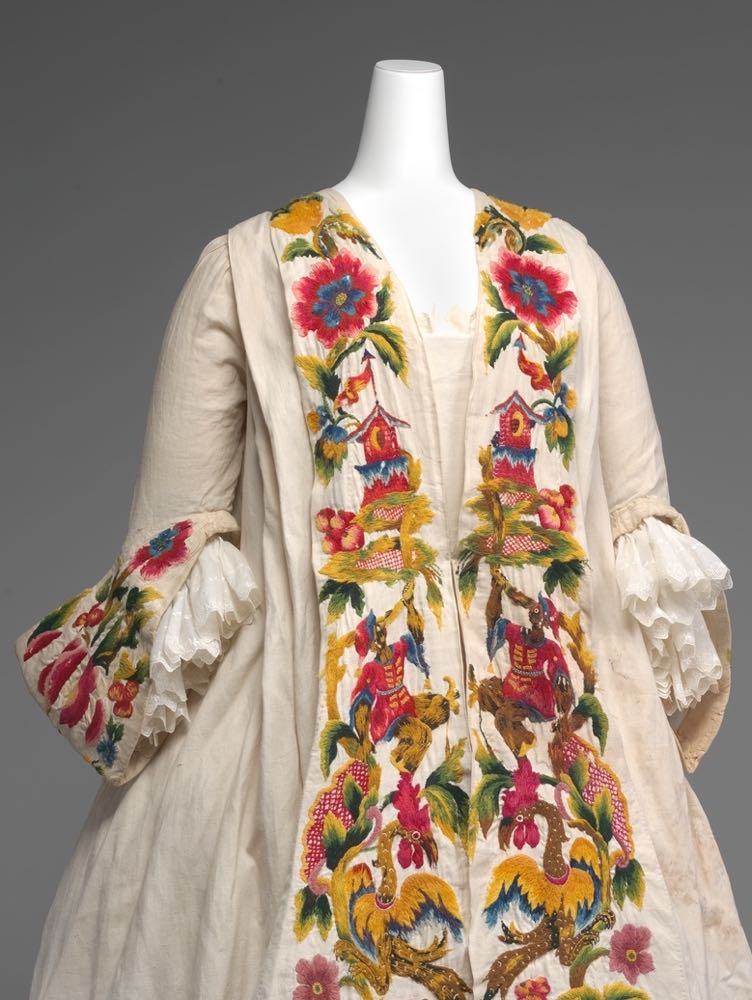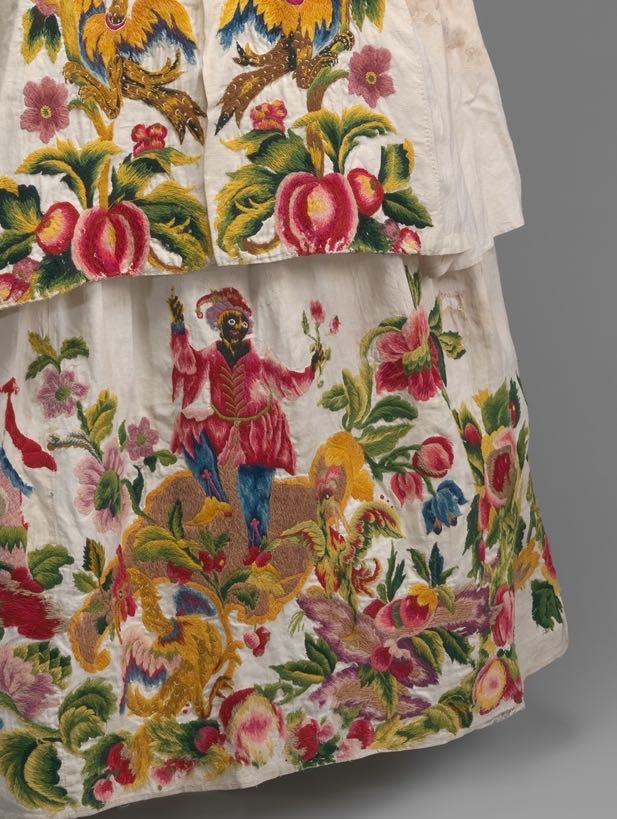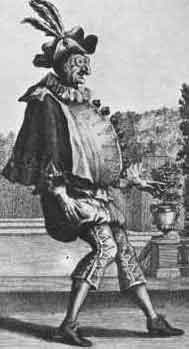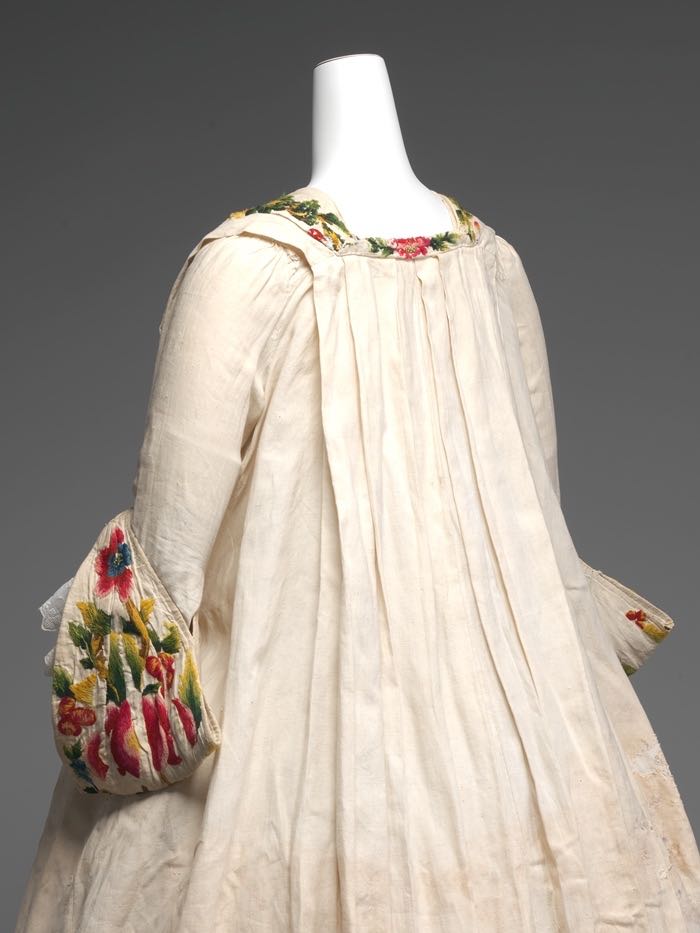Welcome to Rate the Dress! This week we go from chintz to casaquin (and I know that’s kind of comparing apples and asparagus…)
Last week: 1890s theatrical sweetness
Last week we looked at a sweet florals and ruffles 1890s dress which may have been a fashion garment, or a theatre costume. You almost unanimously liked the fabric. You were less sure about the rest. And there was something about the outfit that just wasn’t quite one thing or another – there were SO MANY #.5 ratings!
The Total: 7.9 out of 10.
Better than I expected actually! I guess the gorgeous fabric did the trick!
This week: 1720s-40s theatrically-embroidered casaquin
This week we turn from an ostensibly normal dress which may actually have been a theatre costume, to an unusual high-fashion outfit with theatrical inspiration.
This early-mid 18th century outfit features a loose jacket (casaquin) and petticoat of ivory linen, both lavishly embellished with polychrome wool embroidery.
The casaquin & petticoat ensemble is an early example of the 18th century obsession with turning lower class garments into fashionable dress (other examples are bergere and marmotte).
Despite the working class inspiration, relatively humble linen base and wool (rather than the more common, and more obviously luxe, silk) embroidery, this is definitely a high-status garment. The standard of workmanship is excellent. The white linen would have taken work to keep clean, and the brilliant embroidery involved expensive dyes. More obviously, the garment is a walking advertisement of worldliness.
Not only is the embroidery an obvious example of chinoiserie, the dancing jester figures, which represent the Four Continents (the world was simpler in 1725) show the influence of designers such as Jean Berain who created costumes for royal fetes and theatricals.
In one garment the wearer is able to demonstrate their familiarity with exotic design, geography, and the latest artistic trend. At the same time, they are on the cutting edge of fashion: blending luxury and faux-casual comfort drawn from working attire.
What do you think? Is it all a little too gauche and hip? A middle-aged teacher trying to use all the hottest slang? Or the perfect encapsulation of all that was fashionable and relevant?
Rate the Dress on a Scale of 1 to 10
(as usual, nothing more complicated than a .5. I also hugely appreciate it if you only do one rating, and set it on a line at the very end of your comment, so I can find it! Thanks in advance!)











Oh wow … who knew they had hippies in the 1730s? Just add love beads and leave out that panel in the neckline. It’s definitely an ancestor, or at least a cousin, of the Mexican embroidered long skirt/blouse that was popular in the 1960s.
For its purpose, which was probably strolling through the palazzo and gardens in a humid Roman summer, it’s excellent. It would also be a good pregnancy gown. I like the use of color against the neutral and bold (also fast) embroidery with the coarse wool yarn.
I know I tend to score generously, but this has no serious design defects, and scores points for the embroidery and color.
8.5
The embroidery is gorgeous; it practically looks painted on! Not wild about the faux-casual silhouette though.
8 out of 10.
I actually like the silhouette and the base fabric, but I find the embroidery clunky (although I do appreciate the exuberance of the colors).
\
7 of 10
How fun!! Someone with some serious verve wore that!
10/10. I vote emotionally!
Oh, this has my heart aflutter. I love everything about this gown. I have a sketch I made about a shirtdress I wanted to sew and embroider, white wool with an array of colours. Its really baffling how similar they are. I would wear that jacket now in a heartbeat, maybe even the whole thing… 😉
I was a bit torn on the faces, I don’t like faces as decor or on clothes, but this is racially diverse without glaring stereotypes considering the times… (Did you see JasikaNicole colouring the faces on her fabric?)
10 out of 10.
Not something I could wear in my usual persona, but wow it’s gorgeous! Someone with serious personality would get away with it.
10/10
Long-time reader, first-time commenter, if I saw somebody wearing this in any era I would have to ask them about it.
The white linen is a perfect backdrop to the subtle lustre of wool embroidery and my! what a selection of colours! While individual areas pull more yellow, pink, green, blue, the balance of colours over the entire garment is exquisite. Not only are the close-ups of the technical execution of the embroidery pristine, the designer clearly has a sharp mind for considering the final effect and balance of the outfit.
If there were a production of Othello set in the 18th century this would be Desdemona’s gown: worldly, luxurious, practical, cool.
10/10
The embroidery is amazing! Such beautiful use of colour and shading. And you know how much I approve of intellectualism in fashion. It looks comfy too, and being linen would have been ideal for summer (as long as you didn’t have to do any work that would get it dirty).
All up, a perfect 10/10.
I love it ! The embroidery is amazing. Colorfull and well done. I am not familiar with this time, but I like to combination of jacket and skirt. Does someone know, what a lady would wear beneath ?
10 of 10
I really dislike the silhouette on this one. The embroidery’s fantastical and wonderfully done but not all that attractive.
2/10
I absolutely LOVE it. In fact, I’d totally wear that. Around the house even. 10!
I tend to prefer more stylized embroidery, but still I think the over-all impression is beautiful. While the embroidery is bold and colorful, imagine this gown in the context of boldly patterned 1730s Spitalfield silk mantuas, and it looks almost restrained due to the large white areas. On a woman with dark hair and eyes, I think it would look more balanced than on a headless mannequin.
It seems that the embroiderer has taken care to leave un-embroidered areas on the cuffs so that they can be pleated all the way to the bottom edge, but now the pleats been smoothed out and these areas show as white stripes across the design. With the pleats in place, the embroidery would’ve seemed to run uninterrupted across the cuff, and the cuff proportions would’ve been different.
8/10
I usually don’t like things that don’t have a super defined waist, but I absolutely love this. Partly it’s the glorious embroidery, and partly the so wrong it’s right OTT ness of it all.
10/10
Would 100% wear and swish around in and be the coolest/most noticeable person in the room!
I’m surprised the embroidery is still so vibrant. Personally I don’t like embroidered human figures but the colours against the linen are striking. So 7.
I feel quite conflicted about this one. While I love the idea of vibrant embroidery on an almost austere white background, it’s all just slightly off. Perhaps it’s because the embroidery is just a little bit too bright, and watching it is like listening to some music with too many melodies at once to pay attention to any of them (mostly on the petticoat because of that thick band of embroidery). Also, I think the embroidery is kind of ‘almost there but not really’ when it comes to faith to actual Chinese embroidery of the period, for a lot of reasons that it would take a lot of space to explain (e.g. the white colour of the background, the wool thread used, the colour of the embroidery…) and that would take some points off but overall I think the shape and proportion is really nice and it would be perfect for a summer dress as long as you don’t look too closely at the embroidery. in conclusion, I would give it an 8/10.
This dress is stunning! It looks like it would have been comfortable to wear while also being quite the showpiece. I love the vibrant embroidery, and how much detail it has while still looking good from a distance. The “four continents” is a great theme and a great way to show off your sophisticated worldly knowledge.
10/10.
A stunning achievement!
10/10
Amazing needlework 10
Reminds me of Brazilian bahiana (from the state of Bahia) embroideries done for the season of carnaval where the costumes are elaborate and very colorful. The coolness of the fabric would help the wearer be able to stand warm weather and/or the stage in an era when, even for carnaval, the women were covered in full length dresses/skirts.
My rating is 8.5. The faces are creepy, I would have left them off.
So gorgeous, so intricate, and I’ll bet it was really comfortable to wear. 9/10
I think it’s hideously in-your-face with embroidery so bright it makes me think of Mexican blankets. I LOVE IT. It’s so weird. I’m sure it has to be on the earlier side of the date range because it brings to mind someone’s interpretation of the early “bizarre silks” but in embroidery version instead. The silhouette is one of my favorites but then I’m partial to anything first half of 18thc.
I wouldn’t wear it but I enjoy the eye-blistering hubris of it and kind of want to make one just to say I did it. 9/10
If I could give this 30/10 I would. Because I’ve been back burner obsessed with a coat with an embroidered front border for years (still not found the right ingredients) and this is gorgeous. And the colours are so vivid still after nearly 300 years. I wonder if it didn’t get worn much and was put away, it is so marvelously fresh and new looking.
10/0
Stunning dress, my critical faculties just went right out off the door when I saw it.
10/10, as it sets my heart a-flutter, God knows why.
The colors are lovely, but the faces seem a bit uncannily proportioned to me, and I am not really a fan of the silhouette.
5/10
Not very keen on the whole dress, but the embroidery is so very good. It must hve taken hours of work & I wonder if many women were involved embroidering it. Seems a lot of work & time for one person.
8/10
I have gone on record at some previous RTD that I like 18th century’s take on loose top over wide skirt better than the 1860s one.
I’m glad I didn’t get that confused. I like this a lot. My only gripe is that the slight crudeness of the crewel embroidery (part of its charm!) doesn’t entirely work with the motifs used (it’s kind of the same sort of thing one sees painted on chateau walls, that sort of refined and slightly meh, too refined stuff…)
9/10.
… okay, maybe not crewel? I’ve just realised my terminology may be confused.
… aaand, hopefully not confused after all… 😀
Hello there.
I’m usually only a very interested reader but this dress touched a nerve.
When I saw this dress I suddenly realized: this is what I have always been hoping to find during my pregnancies.
Quite probably it was not specifically made for a pregnant lady. (I don’t know, did they but even have special maternity wear in those days?) But I think it would work splendidly for that purpose.
It looks so roomy and comfortable yet at the same time graceful. The vibrant colours show so much joy of living but in its
funny way it is also quite difnified.
To me this dress says, in a very loud voice, “Look at me! I am alive! Miracles are happening within my body but don’t let us talk about it. I am beautiful and increasingly so, and the world is a wonderful place!”
Whis is how I usually feel when expecting.
And then I always had to face the drab reality of black whale-lookalike or pink fluffy cutie maternity wear at the shops. So depressing.
I’m usually not too keen on brightly colourful chlothes but the embroidery on this one is very special.
I would love to wear this dress in any circumstances because I really like the silhouette.
But if I was told I could have something like this as my new maternity gown, I should be seriously tempted to have another baby.
10 points from me.